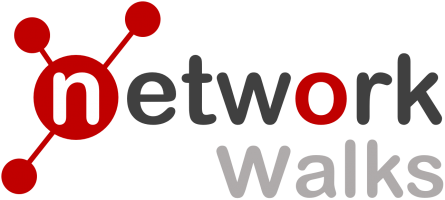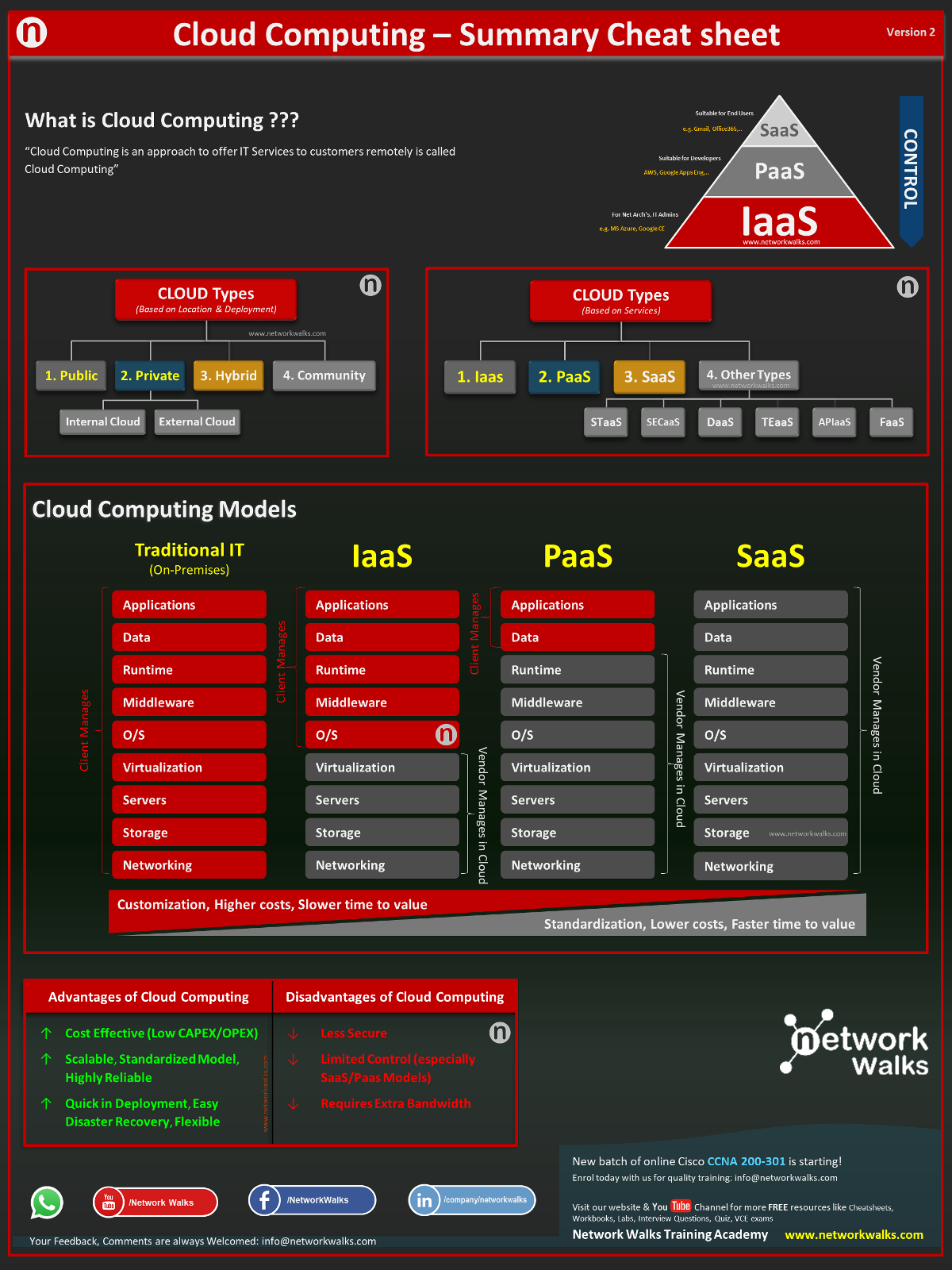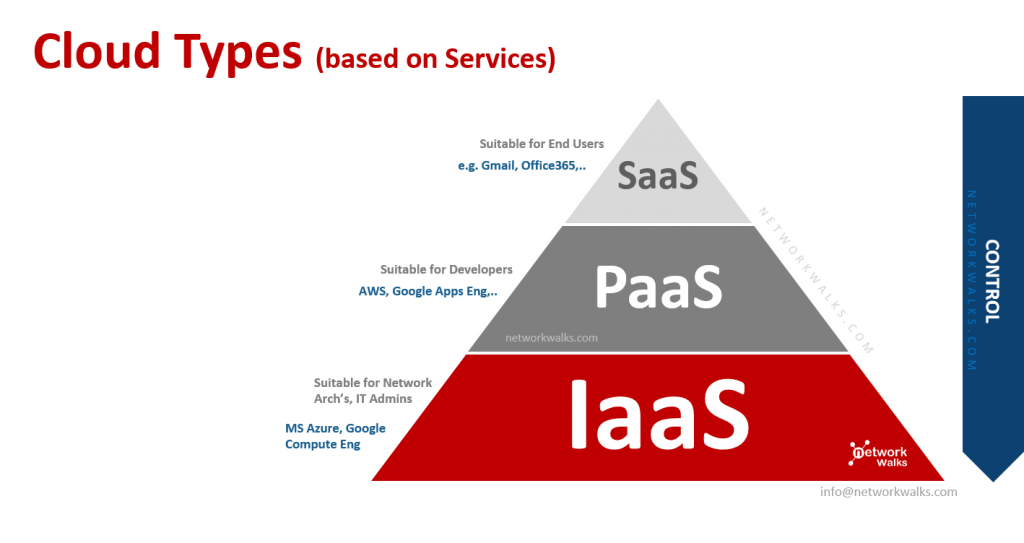
Cloud Computing is an approach to offer IT Services to customers remotely. It is the practice of using IT Network which are physically hosted in a remote location (mostly on the Internet) to store, manage and process data, rather than a local server or a personal computer. It is the delivery of hosted services over the internet. Simply, it is the technology of distributed data processing in which some scalable information resources and capacities are provided as a service to multiple external customers through Internet technology.
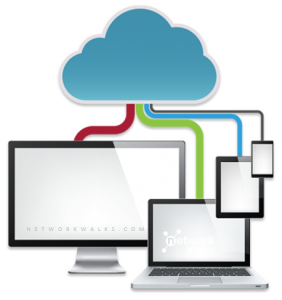
Cloud computing is generally referred to the delivery of computing services over the Internet. Cloud services allow individuals and businesses to use IT & Network resources which include software and hardware that are managed by third parties at remote locations. Examples of cloud services include online Email services (like Gmail), file storage (Like Google Drive, Dropbox), social networking sites (Facebook, Youtube) and online business applications. The cloud computing model allows access to information and computer resources from anywhere that a network connection is available. Cloud computing provides a shared pool of resources which is not managed by the user/client.
Cloud concept is not a new thing. The concept of Cloud Computing came into existence in the 1950s with the implementation of mainframe computers. Since then, it has evolved and now it is gaining attention of the enterprises for its benefits. The emerging trends in Cloud Computing indicate that this technology is transforming rapidly. The upcoming years hold great potential for innovation in Cloud technology.
Cloud Service Characteristics
Below are the criteria for a service to be considered as a cloud service:
- On-demand self-service: First of all, the service must be available on-demand & in the form of self-service. The IT consumer chooses when to start and stop using the service, without any direct interaction with the provider of the service
- Broad network access: The service must be available from many types of devices and over many types of networks including the Internet
- Resource pooling: The provider creates a pool of resources and dynamically allocates resources from that pool for each new request from a consumer, instead of dedicating specific servers for use only by certain consumers
- Rapid elasticity: To the consumer, the resource pool should appear to be unlimited, it should be able to expand quickly and the requests for new service should be filled quickly
- Measured service: The provider can measure the usage and report that usage to the consumer, both for transparency and for billing
Cloud Service Advantages & Disadvantages
There are many Advantages and Disadvantages that come with Cloud. Although cloud brings in the Cost Efficiency and scalability but organisations are concerned about Cloud security & their limited control over Cloud. Below table lists Pros & Cons of Cloud Computing:
Advantages
- Cost Effective: CAPEX & OPEX with cloud are easy to manage & low
- Scalable: Cloud is scalable. We can even automate the process
- Standardization: Cloud model is more standardized as compared to traditional IT Networks
- Reliability: Services are hosted across multiple servers so individual system failures do not affect the continuity of the service
- Quick Deployment: Deployment is more flexible with Cloud Model
- Disaster Recovery: DR is easy with Cloud
- Flexibility: Great choice in the level of security and management, with an option to suit almost any business
- Manageability: Simplified IT management and maintenance capabilities through central administration of resources
Dis-advantages
- Security: Cloud is considered to be less secure as compared to private/local IT/Network
- Limited Control: Organizations have less control on the cloud especially with the SaaS & Paas Models
- Bandwidth: Bandwidth is also a concern which is needed for access & management of cloud
Cloud Types (based on Location & Deployment)
There are different models available in terms of Deployment of cloud services including Public, Private, Inter/External, Hybrid & Community.
1. Public
“A type of cloud in which services and infrastructure are hosted off-site by a cloud provider, shared across their client base and accessed by these clients via public networks such as the internet”
In Public cloud, services are generally offered over the Internet. These are owned and operated by a cloud provider. Some examples of Public Cloud include services aimed at the general public, such as Email services (like Gmail), file storage (Like Google Drive, Dropbox), social networking sites (Facebook, Youtube). However, services for enterprises can also be offered in a public cloud.
From a customer perspective, the public cloud offers a way to gain new capabilities on demand without investing in new hardware or software. Instead, customers pay their cloud provider a subscription fee or pay for only the resources they use. Simply by filling in web forms, users can set up accounts and spin up virtual machines or provision new applications. More users or computing resources can be added on the fly—the latter in real time as workloads demand those resources thanks to a feature known as auto-scaling.
2. Private
“A type of cloud in which cloud infrastructure is hosted on a private space only for a specific organization and is managed by the organization itself or a third party”
Private cloud downsizes the technologies used to run IaaS public clouds into software that can be deployed and operated in a customer’s data center. As with a public cloud, internal customers can provision their own virtual resources in order to build, test, and run applications, with metering to charge back departments for resource consumption. For administrators, the private cloud amounts to the ultimate in data center automation, minimizing manual provisioning and management.
The obvious benefits to this are greater levels of security and control. Cost benefits must be sacrificed to some extent though, as the enterprise in question will have to purchase/rent and maintain all the necessary software and hardware.
- Internal Cloud – Local hosted Private Cloud (on-premises)
“A type of cloud in which cloud infrastructure is operated for a specific organization and is also managed by the same organization itself”. This type of cloud model is more suitable of companies that have critical data & don’t want to risk their security by relying on some one for their data security.
- External Cloud – Remote hosted Private Cloud (off-premises)
“A type of cloud in which cloud infrastructure is operated for a specific organization but it is managed by some other organization”. This type of cloud model is more suitable of companies that do not have critical data & need flexibility & other benefits of cloud.
3. Hybrid
Hybrid Cloud is a mixture of multiple cloud types.
It is an integration of a private cloud with a public cloud. At its most developed, the hybrid cloud involves creating parallel environments in which applications can move easily between private and public clouds. In other instances, databases may stay in the customer data center and integrate with public cloud applications—or virtualized data center workloads may be replicated to the cloud during times of peak demand.
A hybrid cloud allows a company to maximise their efficiencies; by utilising the public cloud for non-sensitive operations while using a private setup for sensitive or mission critical operations, companies can ensure that their computing setup is ideal without paying any more than is necessary.
4. Community
“A cloud service model that provides a cloud computing solution to a limited number of individuals or organizations and it is managed by all the participating organizations or a third party managed service provider”
In a community cloud, the service is shared by several organizations and made available only to those groups.
A community cloud is a multi-tenant platform which allows several companies work on the same platform, given that they have similar needs and concerns. One example of using a community cloud would be to test-drive some high-end security products or even test out some features of a public cloud environment. This is great for organizations that are driven by compliance and regulatory measures.
Although community clouds are still new as compared to other models but they are becoming more and more important with general cloud adoption across industries. They can be a good solution for both the service provider, who gets better margins with higher value services, and for the client, who can be sure that its industry-specific needs and regulatory requirements are met in a professional way.
Cloud Types (based on Services)
Cloud types can be classified based on the responsibilities of the client & Cloud Provider. Broadly speaking, there are 3 models of cloud computing which describe the service on offer. Given that use of cloud computing services spans across the consumer and the provider organization, responsibilities can be spread across both organizations and, vary depending on cloud delivery model and service. Below table summarises the different types of Cloud & the detailed responsibility matrix:

1. IaaS (Infrastructure as a Service)
“IaaS is a type of cloud computing model in which IT/Network Infrastructure management is the responsibility of Cloud Provider while OS and Applications management are the responsibility of Client”
IaaS refers to the delivery of virtualised computing resource as a service across a network connection. IaaS specifically deals with hardware – or computing infrastructure – delivered as a service. Offerings include virtualised server space, storage space, network connections and IP addresses. The resource is pulled from a pool of servers distributed across data centres under the provider’s control, the user is then granted access to this resource in order to build their own IT platforms. IaaS can provide enterprises with great business benefits.
2. PaaS (Platform as a Service)
“PaaS is a type of cloud computing model in which IT/Network Infrastructure, OS & Run-time management is the responsibility of Cloud Provider while only Applications management is the responsibility of Client”
PaaS is an extension of IaaS and describes a category of cloud computing that provides developers with environments in which to build applications over the internet. In addition to the fundamental computing resource supplied by the hardware in an IaaS offering, PaaS models also include the software and configuration (often known as the solution stack) required to create the platform on which clients can create their applications. PaaS packages can be tailored to meet individual user needs; they can cherry pick the features of the service that are relevant to them while disregarding those that are not. PaaS provides a number of benefits to enterprises, including simplifying the development process for geographically split development teams. Google Apps Engine (GAE) is an example of PaaS.
3. Saas (Software as a Service)
“SaaS is a type of cloud computing model in which all responsibilities belong to Cloud Provider including IT/Network Infrastructure, OS & Run-time and even the Applications”
Client just connects to cloud & uses the applications. SaaS is arguably the most common of the cloud computing variations; it’s the term used to describe a software delivery model in which applications are hosted (usually by a provider) and made available to customers over a network connection. Many people make use of SaaS without realising it as many web applications are delivered in this way. Example of SaaS is Gmail, where Google is the provider and we just end users.
4. Others
There are some other types of Cloud Computing as well which are either a subset of the above three main models or the fusion of them. These models are listed in below:
- STaaS (Storage as a Service)
- SECaaS (Security as a Service)
- Others – DaaS (Data as a Service)
- Others – TEaaS (Test Environment as a Service)
- APIaaS (API as a Service)
- FaaS (functions as a service)
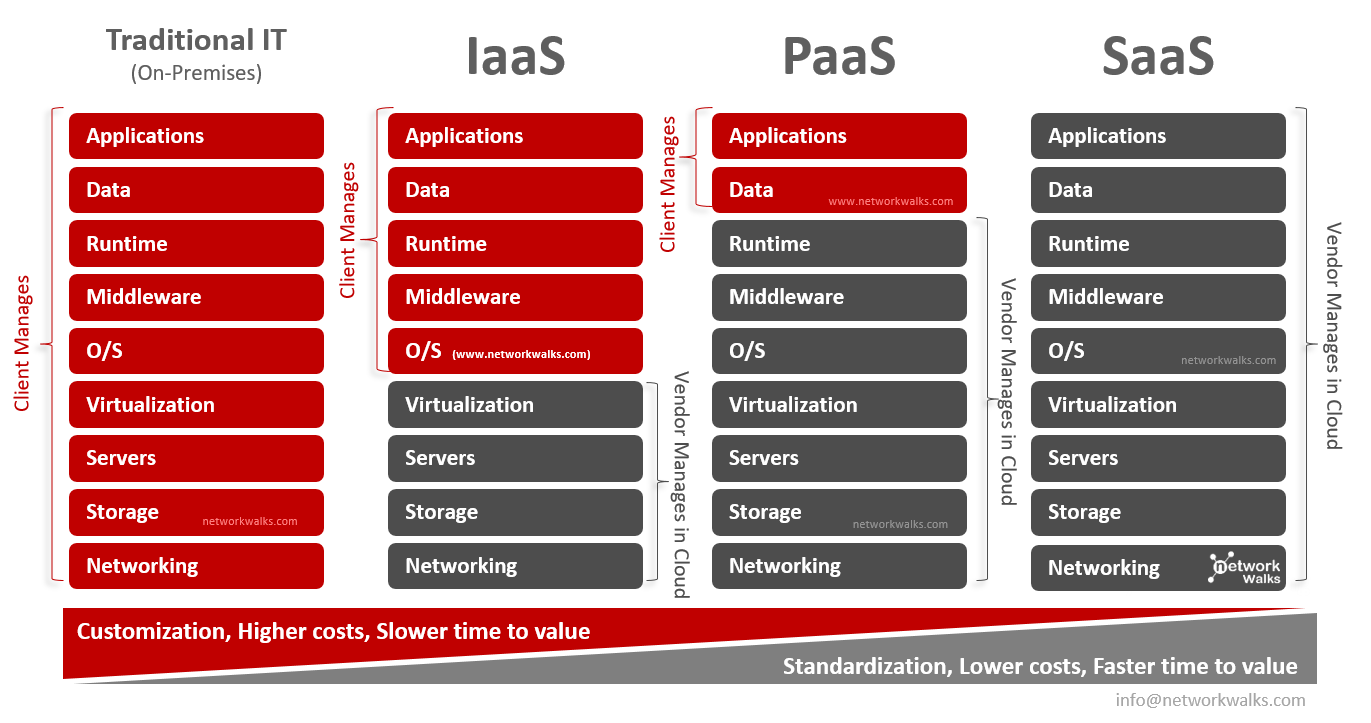
Connecting to Cloud
There are mainly two methods to connect the Public Cloud which are through the Internet and through the Private WAN.
*Connection to Private Cloud is not important because using a private cloud (which is internal to an enterprise) has much less of an impact on an enterprise WAN compared to public cloud. With public cloud, the cloud services exist on the other side of some WAN connection as compared to the consumer of the services. So network engineers must think about how to best build a WAN when using public cloud services.
1. Connecting to Public Cloud via Internet
We can simply use the Internet to connect to the Public Cloud. Using the Internet to connect from the enterprise to the Internet has several advantages. The most obvious advantage is that all companies and cloud providers already have Internet connections, so getting started using public cloud services is easy. Using the Internet works. The following list summarizes the advantages and disadvantages to use the Internet as the WAN connection to a public cloud service:
Advantages
- Agility: An enterprise can get started using public cloud without having to wait to order a private WAN connection to the cloud provider
- Migration: An enterprise can switch its workload from one cloud provider to another more easily because cloud providers all connect to the Internet
- Distributed users: The enterprise’s users are distributed and connect to the Internet with their devices
Disadvantages
- Security: The Internet is less secure than private WAN connections
- Capacity: Moving an internal application to the public cloud increases network traffic
- Quality of Service (QoS): The Internet does not provide QoS, whereas private WANs can
- No WAN SLA: ISPs typically will not provide a SLA for WAN performance and availability
2. Connecting to Public Cloud via Private WAN
The other options to connect to Public Cloud include Private WAN, VPN Tunnel and MPLS. To make a private Multiprotocol Label Switching (MPLS) VPN or Ethernet WAN connection, the enterprise needs to work with the cloud provider and the WAN provider. Because cloud providers connect to many customers with private WAN connections, they often have published set instructions to follow. In the most basic form, with MPLS, the enterprise and the cloud provider connect to the same MPLS provider, with the MPLS provider connecting the enterprise and cloud sites. The same basic process happens with Ethernet WAN services, with one or more EVCs created between the public WAN and the enterprise. Using the Private Networks to connect from the enterprise to the Internet has several advantages and disadvantages associated with them which are listed in below:
Advantages
- Better Data/Network Security: All private WAN options improve security significantly
- QoS: WAN services like MPLS VPN and Ethernet WANs provide better QoS
- Capacity: Private WAN provides better Capacity Management
Disadvantages
- Agility: Installing the new private WAN connections takes time
- Cost: Private WANs typically cost more than using the Internet
- Mobility: Migrating to a new cloud provider can require another round of private WAN installation
Cloud Computer Cheatsheet:
-End-
Related pages:
Follow our Facebook Page and YouTube Channel for more updated Cheatsheets Quizzes:
